Circuit Control
Circuit Control
I'm still trying to wrap my head around logistics. What I am looking for is a simple tutorial on how to control the number of items on a belt. For example, I have a full belt of red circuits feeding a loop that feeds my blue circuit assemblers. This same loop is used to off load the finished product, but keeps getting jammed up with red circuits. How can I control it so the loop doesnt jam with red circuits?
Re: Circuit Control
Two things come to my mind immediately:
1. The simple solution:
As there are only two types of items involved in this problem you can use the two different lanes of the belt to separate the two types. eg red chips on the inner lane and blue chips on the outer lane of the loop.
to achieve this you need to understand these concepts (i am assuming you are a new player):
- side loading from one belt to only one lane of another belt
- inserters priorize the lane closer to them when trying to grab items from a belt and more importantly to this case, inserters ONLY place on the far lane, when trying to put items on a belt
- separating types of items by using filter splitters
additionally it is helpful to understand the basic implementation of a (forward) lane balancer.
1. The simple solution:
As there are only two types of items involved in this problem you can use the two different lanes of the belt to separate the two types. eg red chips on the inner lane and blue chips on the outer lane of the loop.
to achieve this you need to understand these concepts (i am assuming you are a new player):
- side loading from one belt to only one lane of another belt
- inserters priorize the lane closer to them when trying to grab items from a belt and more importantly to this case, inserters ONLY place on the far lane, when trying to put items on a belt
- separating types of items by using filter splitters
additionally it is helpful to understand the basic implementation of a (forward) lane balancer.
Re: Circuit Control
2. the sophisticated (but maybe overcomplicated) solution would be to count how many items are on the looping belt by using combinators and
to stop insertion of items if a certain degree of saturation is detected.
in your case it would suffice to count how many red chips are on the loop. placing on the loop via belt or inserters counts up, taking from the loop via inserters counts down. if eg, the saturation of the loop with red chips is 70% (each piece of belt can hold 8 items), you would simply cut off supply of red chips.
as inserters place only on the far side of the belt, meaning, they would place the blue chips only on the far lane, it is advisable to funnel the red chips mainly onto the close lane, so the remaining, free slots happen to be on the far lane.
to stop insertion of items if a certain degree of saturation is detected.
in your case it would suffice to count how many red chips are on the loop. placing on the loop via belt or inserters counts up, taking from the loop via inserters counts down. if eg, the saturation of the loop with red chips is 70% (each piece of belt can hold 8 items), you would simply cut off supply of red chips.
as inserters place only on the far side of the belt, meaning, they would place the blue chips only on the far lane, it is advisable to funnel the red chips mainly onto the close lane, so the remaining, free slots happen to be on the far lane.
Re: Circuit Control
There are ways to have all kinds of different items on the same belt but, as said, generally people stick to two items. One per lane. Make sure the red circuits are only on one lane. Then use the other lane for the output. You can then use a filtered splitter to filter out the blue circuits.
Often it's even easier to have a dedicated output belt. Then you can equally load it from two sides. But there are builds that can make good use of combined input/output belts.
Often it's even easier to have a dedicated output belt. Then you can equally load it from two sides. But there are builds that can make good use of combined input/output belts.
Re: Circuit Control
Yep, it's super simple to circuit-network equal counts of any number items onto a belt. You just need 1 decider combinator that becomes a counter set to "Each >= 0 Output Each" that is self-bridged, then you configure each belt input(which is also set to priority input from the sushi belt loop) to sideload onto the output; the 2 belt segments are "read contents, pulse" and then enable on: "item1 <= item2" on input belt 1; "item2 < item3" on input belt 2; "item3 < item1" on input belt 3. IIRC this should cause a loop of conditions that keeps the items on the belt equivalent. And it's trivial at this point to ratio each item, by just putting intermediate arithmetic combinators between the counter combinator and the belting.Impatient wrote: ↑Sun Aug 30, 2020 12:20 pm 2. the sophisticated (but maybe overcomplicated) solution would be to count how many items are on the looping belt by using combinators and
to stop insertion of items if a certain degree of saturation is detected.
in your case it would suffice to count how many red chips are on the loop. placing on the loop via belt or inserters counts up, taking from the loop via inserters counts down. if eg, the saturation of the loop with red chips is 70% (each piece of belt can hold 8 items), you would simply cut off supply of red chips.
as inserters place only on the far side of the belt, meaning, they would place the blue chips only on the far lane, it is advisable to funnel the red chips mainly onto the close lane, so the remaining, free slots happen to be on the far lane.
Re: Circuit Control
Another option is to read belt contents, for example from 5 belts, and insert if number is low. This takes probably more UPS and is ugly, but is immune to electric blackouts, which affect counters and may lead to jamming. I made once this kind of system to feed a mall in Bob's mods. It has about 10 different items in belt loop from which assemblers took what they needed (I had separate loops for different tiers). It worked flawlessly more than hundred hours in such very low throughput use, but I would not use it in circuit production. Eventually you expand your factory and regret why not put separate belts (or at least belt sides). It is nice to try this kind of contraptions, but there is not many places they give more advantage than joy of building even with very complex mods, like Bob's.Impatient wrote: ↑Sun Aug 30, 2020 12:20 pm in your case it would suffice to count how many red chips are on the loop. placing on the loop via belt or inserters counts up, taking from the loop via inserters counts down. if eg, the saturation of the loop with red chips is 70% (each piece of belt can hold 8 items), you would simply cut off supply of red chips.
Re: Circuit Control
This image might be helpful, because it demonstrates 2 useful concepts..... Side loading, and Splitter filtering
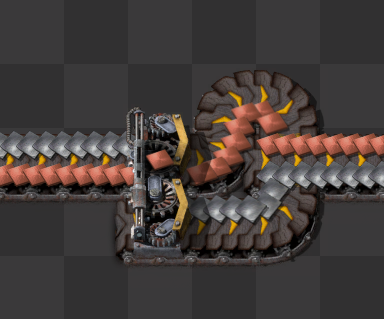
Side loading is a concept where a belt intersects with another belt perpendicular, it'll place items on that one side of the belt. Notes this does NOT work on L bends (by design), so side loading requires (at minimum) a T intersection configuration of the belts. You can also have 2 belts face inward on either side of a middle belt (face perpendicular) to convert a L-bend into a T-section.
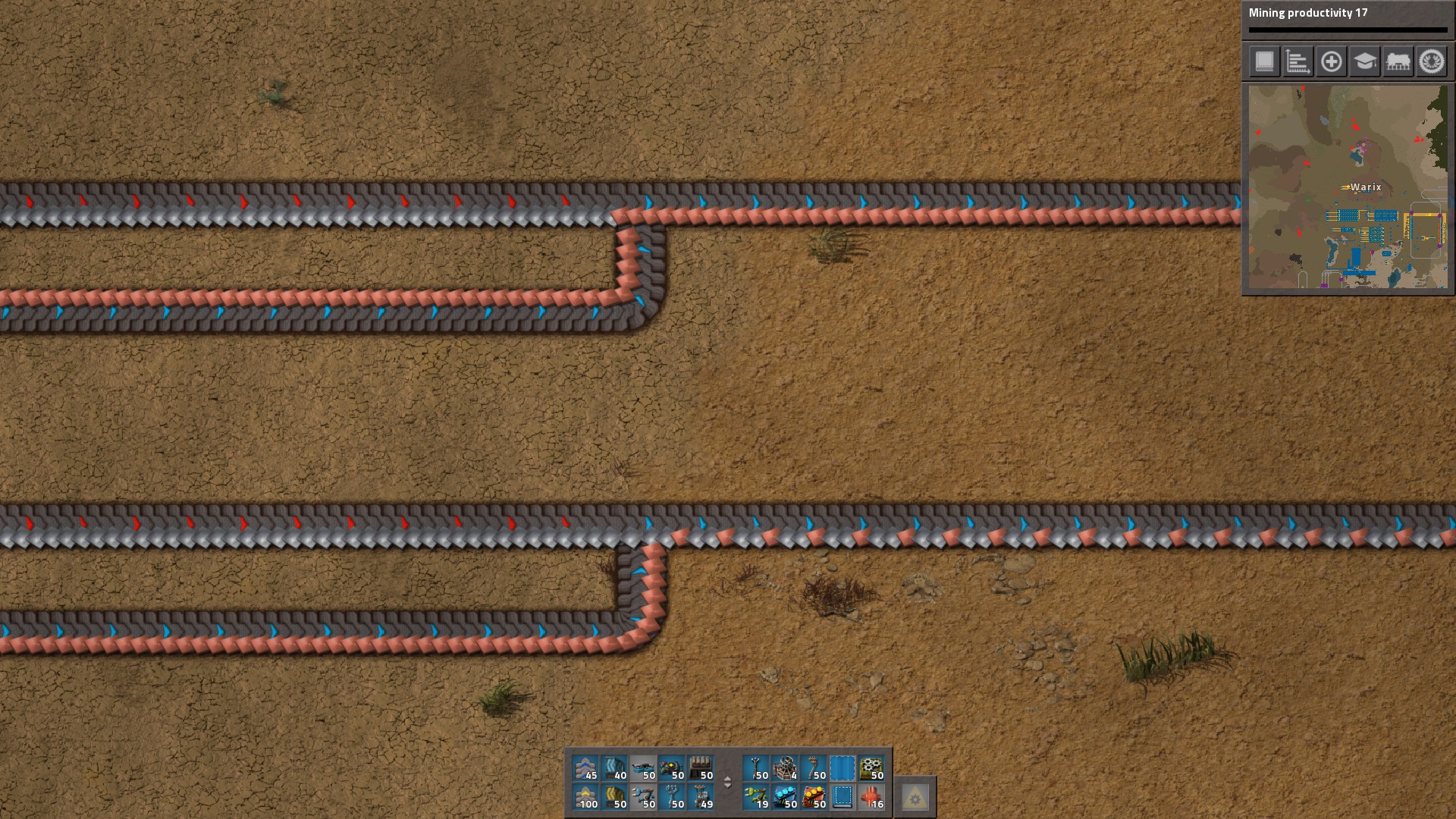
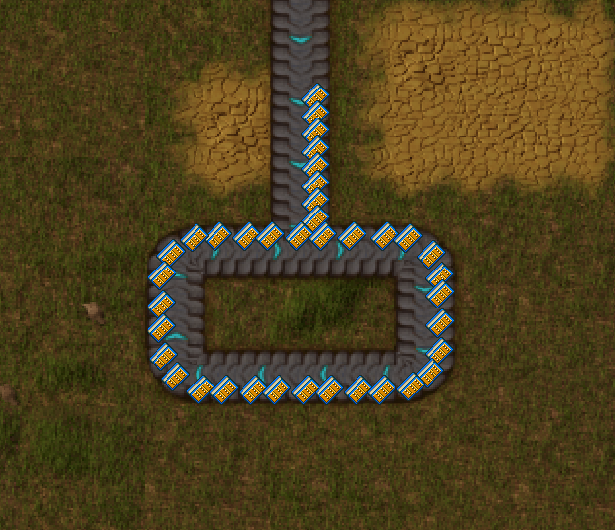
This picture below demonstrates the Inserter behavior mentioned above. Inserters prioritize near side for grabbing, but far for placing. There another quirk for parallel facing belts, but thats for more advanced builds.
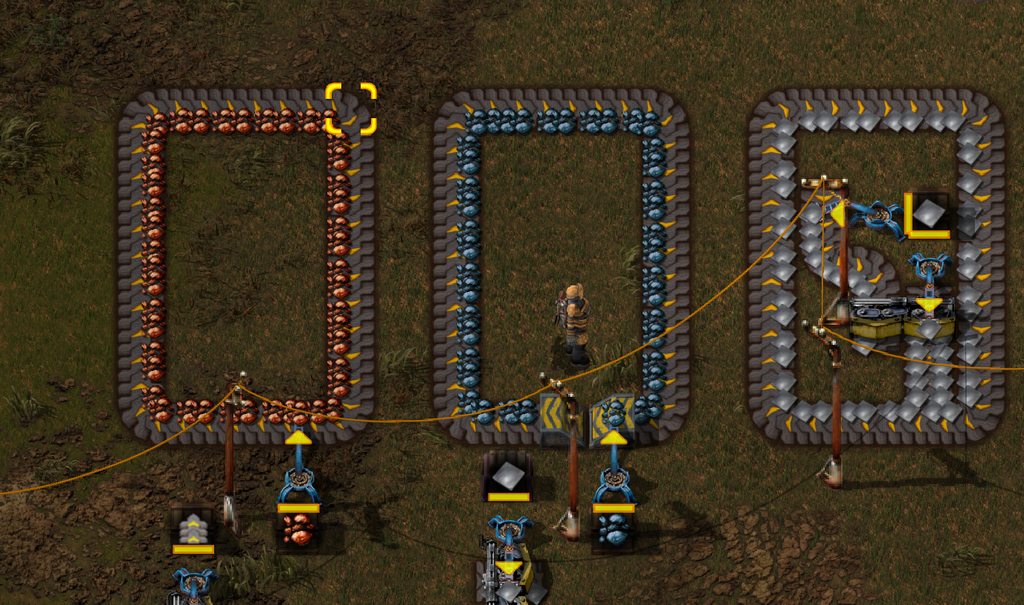
Generally you don't want to mix items on belts without having very careful lane control, since bad lane control is what leads to the kind of stalling you're getting. And the only way to fix that kind of stall requires filter logic and chest buffering.... both which are overly complicated, and easily avoided for fixed Input/output arrangements.
For Assemblers that need 3 or more items, you a few options.
A. 2 belts on side of a machine (offering 4 lanes), and long inserters to reach the outside belt. it requires extra space, but the design is extremely simple.
B. Belt weaves. Where you use underground belts and regular belts to weave them within reach of the AM. This set up still takes the same amount of space as 2 belts, but doesn't require long inserters. This gets used more in high volume recipes where Long inserters are too slow to keep up.
C. Underground Belt Weaves. This takes advantage of different colored underground belts having different ingress/egress checks, allowing you to compress 2 belts into the same width as 1 belt. This REQUIRES the use of different colored belts, and thus has issues in late game where red belts might lack the bandwidth for what you're doing.
I made a picture showing belt weaves and inserter placement in action.
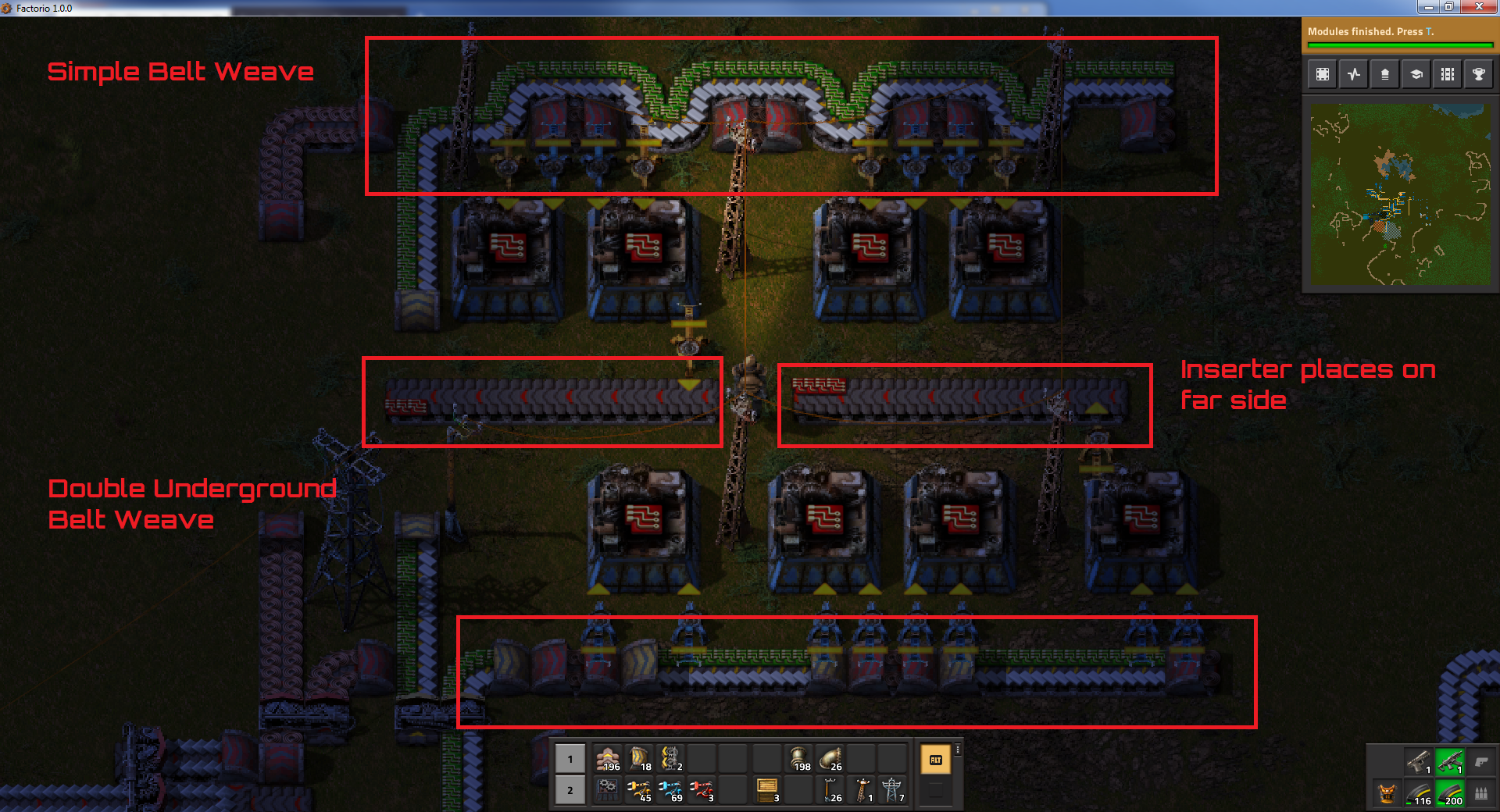

Side loading is a concept where a belt intersects with another belt perpendicular, it'll place items on that one side of the belt. Notes this does NOT work on L bends (by design), so side loading requires (at minimum) a T intersection configuration of the belts. You can also have 2 belts face inward on either side of a middle belt (face perpendicular) to convert a L-bend into a T-section.


This picture below demonstrates the Inserter behavior mentioned above. Inserters prioritize near side for grabbing, but far for placing. There another quirk for parallel facing belts, but thats for more advanced builds.

Generally you don't want to mix items on belts without having very careful lane control, since bad lane control is what leads to the kind of stalling you're getting. And the only way to fix that kind of stall requires filter logic and chest buffering.... both which are overly complicated, and easily avoided for fixed Input/output arrangements.
For Assemblers that need 3 or more items, you a few options.
A. 2 belts on side of a machine (offering 4 lanes), and long inserters to reach the outside belt. it requires extra space, but the design is extremely simple.
B. Belt weaves. Where you use underground belts and regular belts to weave them within reach of the AM. This set up still takes the same amount of space as 2 belts, but doesn't require long inserters. This gets used more in high volume recipes where Long inserters are too slow to keep up.
C. Underground Belt Weaves. This takes advantage of different colored underground belts having different ingress/egress checks, allowing you to compress 2 belts into the same width as 1 belt. This REQUIRES the use of different colored belts, and thus has issues in late game where red belts might lack the bandwidth for what you're doing.
I made a picture showing belt weaves and inserter placement in action.





